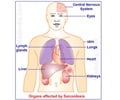In spite of laws that require limiting of the amount of coal dust in mines, coal miners are still prey to 'black lung' or pneumoconiosis, according to a report from the Centers for Disease Control and Prevention.
The Coal Workers' Health Surveillance Program has identified 30 miners with pneumoconiosis from 328 miners who were screened. Among these 11 were diagnosed with advanced disease according to the report by Dr. V. C. Antao and his associates in the CDC's Morbidity and Mortality Weekly Report for August 25.The Federal Coal Mine Health and Safety Act of 1969 has made the limits of 2 milligrams of dust per cubic meter mandatory in areas where miners work. Following this there was a decline in the rate of occurrence of pneumoconiosis. However, it was found that clusters of rapidly progressive coal workers' pneumoconiosis were resurfacing in 1996, especially in Virginia and Kentucky.
Antao's team from the National Institute for Occupational Safety and Health reported that thirty-one percent of approximately 1055 underground coal miners employed in southwestern Virginia underwent screening at mobile examination units. They completed questionnaires concerning their work history and health as well as underwent spirometry to determine lung capacity, and chest X-rays. 30 of them had evidence of rapidly progressive pneumoconiosis. 11 of the most advanced cases had been working in the mines for almost 31 years, and two subjects had started mining before the 1969 limits took effect.
According to the estimates from a related editorial 5.5 cases of advanced coal workers' pneumoconiosis would be expected if dust levels had not exceeded the current limits. However, 11.9 cases would be expected if miners' exposure averaged double the limit.
Therefore they recommended that mandated levels of dust are too high, and must be lowered to the "recommended exposure limit" of 1 milligram per cubic meter suggested by the National Institute for Occupational Safety and Health.
In addition they have also stated that the 11 cases of advanced coal workers' pneumoconiosis should be considered "a sentinel health event and justifies a comprehensive assessment of current dust-control levels."









